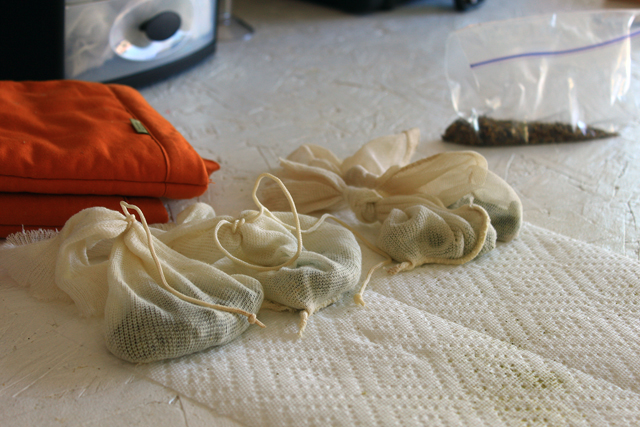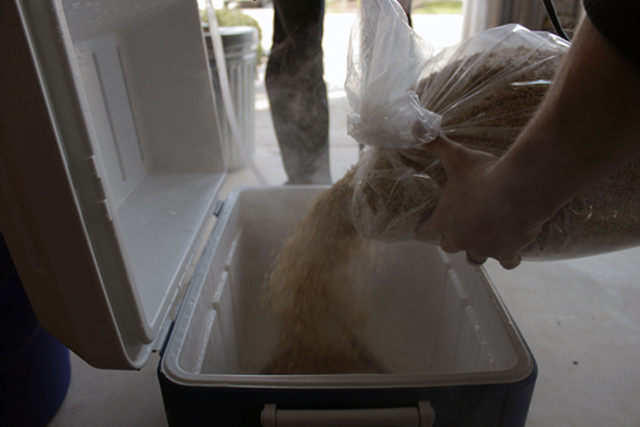 |
| We're always thrilled to have visitors on brew day. We give the brief tour, talk about our method, and share some of our past brews. A day at the Bright Spot homebrewery is always a good one! |
Saturday, May 21, 2011
Double Brew Day! Rapture Red Ale and Hop(e)fulness IPA
Saturday, April 30, 2011
Double Brew Day! Smiling Sky and Ahimsa Amber
 |
| This brew day would be double the fun, and double the work! Up first was a reprise of our Smiling Sky Summer Pale Ale, then we'd try a new recipe, Ahimsa Amber Ale, named after the Sanskrit word which embodies a philosophy of non-violence in body and mind. In the Ahisma we'd work to correct a number of dissatisfying results of our previous amber, Laughing Hyena. |
 |
| For Smiling Sky, the hop presence is what won us over, so the same schedule would be replicated for the second batch. Here bags of Simcoe, Centennial, and Cascade are prepared for their additions. |
 |
| Look at that rich color! And look at that gravity! We were a bit high on that, so we added some cold water after the boil to get it down to our target: right around 1.054. |
 |
| After cooling, Ahimsa flows out of the kettle into the fermenter. We didn't want to bother with aerating, but this long pour likely helped with that. |
Sunday, April 3, 2011
Laughing Hyena Amber Ale
Sunday, March 13, 2011
Smiling Sky Summer Pale Ale
 |
| In a few weeks the pale was ready to keg and carbonate. |
 |
| We collaborated on the design and Chris put the digital skills to work to create the logo, a must for any respectable beer that plans to stay in the rotation. More about this recipe can be found on our keeper beers page, found here. |
Saturday, February 19, 2011
American-Style India Pale Ale
 |
| We couldn't wait to try out this mash tun and get familiar with the all-grain method, which we knew would help us gain much more control over the process. |
 |
| After the hour-long mash, before letting the runoff into the kettle, we captured some "vorlauf" to recirculate to the top of the grain bed. |
 |
| The 15-gallon kettle allowed us to do a "full boil," so the entire wort is included in the kettle. It was a cool evening and a lot boiled off, but we were pretty close to the volume we expected. |
 |
| We prepared a yeast starter in a growler and had a big volume to pitch once we chilled the wort. |
 |
| In a wonderfully synchronous way, our first all grain batch would also be our first batch on tap. We invested in a brand new, beautiful two-tap kegerator, and we can't wait to use it. |
Monday, January 24, 2011
Pale Ale (extract)
 |
| Ingredients for our second (and last) extract beer, a pale ale which we worked to keep simple and clean. |
 |
| Being numbers geeks, we knew we'd want to know the actual gravity of our beers. We wanted to take the brewing process seriously in terms of knowing gravity and final ABV, so a refractometer would do the trick. |
 |
| After a few weeks in the bottles, the carbonation was spot on and we were finally able to get some feel for the results. Right away we could tell there was something "off" about this one. Despite our efforts to develop a pale ale, there was a distinct wheat-like quality to the body and the familiar aroma of a hefeweizen. We could not determine an explanation for this, except to wonder if somehow the online supply store sent us the wrong yeast strain and we didn't notice? |
Friday, January 21, 2011
Converting a Cooler into a Mash Tun
Like most novices, we approached the process of home brewing in the most simple way by using malt extract, which eliminates the need to extract the sugars from the grain ourselves (see prior post for more detail about this process). The upside to this approach is that it is quicker and less complicated; the downside is that it limits the amount of control brewers have over the final characteristics of their beer. The alternative to extract brewing is called all-grain brewing whereby the brewers are responsible for “mashing” and “sparging” their own grain. Basically, mixing extract into hot water is replaced by a process of soaking much larger quantities of milled grain to release sugars (mash) then rinsing those sugars off the grain (sparge). The rest of the process is similar to that of extract brewing: boil, add hops, cool down, add yeast, let ferment, bottle/keg, wait... DRINK!
We decided, after brewing only one batch with extract (IPA), it was time for us to go all-grain (we had already purchased the ingredients for a second extract batch, Super Pale, which we weren’t about to waste). This is a project we were initially somewhat afraid to take on, as it just seemed too complicated and expensive. We couldn't have been further from the truth. After researching the various methods and materials, we found that a very good mash tun could be easily fabricated out of relatively inexpensive materials- we spent about $80.
We probably read over 15 different methods for converting coolers into mash tuns- some offered instructions that seemed unsanitary and flimsy, while others seemed a tad over the top. We blended the best aspects of the few we thought looked good and here is what we came up with:
First, it is important to decide what type of cooler you are going to convert and it is imperative you choose one that has a removable spigot (almost all cooler spigots, when removed, leave a hole with a ½” inner diameter). While the 5 gallon round coolers are a popular choice, many people choose to use larger rectangular coolers for greater volumes of beer. We went with a 48 quart (12 gallon) Coleman cooler. Whatever cooler you choose to use, the mash tun assembly can be easily removed and placed in another cooler at any time!
Mash Tun Parts:
1. Cooler (if used, make sure you thoroughly clean it prior to first batch J)
2. 1 ½” Brass Threaded Ball Valve
3. (2) ½” Barb x ½” MIP Brass Hose Adapter (Watts A-385)
4. ½” Barb x ½” FIP Brass Hose Adapter (Watts A-390)
5. ½” x 1 ½” Brass Pipe Nipple (Watts A-836)
6. ½” Brass Female Pipe Cap (Watts A-819)
7. (3) ¼” Stainless Steel Hose Clamps
8. (3) ¾” Stainless Steel Flat Washers (these are not easy to find on their own; however, you can purchase a ¾”Create-A-Bolt set for about $5… found in every Home Depot and all stainless!)
9. (1) ½” diameter Stainless Steel hose from 12” to about 4’ long- many people go with the less expensive 12” supply hose; we chose the 4’ washing machine fill hose for about $10 (Eastman 98503)
10. (2) ¾” ID Rubber O-Rings with 1/8” wall (#15)
11. About 4’ of food grade plastic tubing (3/4” ID)
12. Teflon plumbers tape
STEP 1: Prepare cooler
Ø Unscrew spigot from cooler making sure to leave the white washer (this not only helps to prevent leaks, but makes for a more secure fitting assembly).
Ø Clean the area around the removed spigot with warm water (this is particularly important for used coolers that are being repurposed).
STEP 2: Prepare stainless steel hose
Ø Cut both ends off of the stainless steel hose (part #9). This can be accomplished by using a pair of sharp wire-cutters (easiest and cleanest) or a hacksaw. I recommend wrapping tape around the ends prior to cutting to help keep the hose together.
Ø Using a pair of needle-nose pliers, grab the inner plastic tubing and gently push the stainless steel mesh down the plastic tubing. DO NOT pull the mesh from the bottom! If you’re too impatient, you might mess up the mesh hose.
Ø Slide 2 hose clamps (part #7) onto the stainless steel hose.
Ø Insert the barbed end of the FIP brass hose adapter (part #4) into one end of the stainless steel hose and secure it with a hose clamp.
Ø Insert the smaller end of the pipe cap (part #6) into the other end of the stainless steel hose and secure it with the other hose clamp.
Ø Set the completed hose assembly aside.
STEP 3: Assemble drainage system
Ø Wrap plumbers tape around the threaded end of one of the MIP brass hose adapters (part #3) and tightly screw it into the longer side of the ball valve (part #2)- see photo for clarification.
Ø Slide the plastic tubing (part #11) onto the barbed end of the MIP Brass Hose Adapter that is attached to the ball valve and secure with the final hose clamp.
Ø Wrap each end of the brass pipe nipple (part #5) with plumbers tape and insert it into the cooler’s spigot hole- this will require some pressure and patience so as not to push the white washer through the spigot hole.
Ø Place an o-ring (part #10) on both ends of the pipe nipple.
Ø Place 1 washer (part #8) on the external portion of the pipe nipple and 2 washers on the internal portion of the pipe nipple.
o It is possible some folks won’t require this many washers, as they are used simply to allow for more secure fastening of the parts. Should you require less, I recommend first trying 1 washer on either side; if there’s still no pipe nipple left, you can remove the washer from external portion of the nipple.
Ø Screw the ball valve assembly onto the external portion of the pipe nipple (might be easier if you remove the plastic tubing).
Ø Screw the stainless steel hose assembly onto the internal portion of the pipe nipple (might be easier if you remove the stainless steel hose from the FIP brass hose adapter).
That’s it! Test it all out by filling the mash tun with a few gallons of water and flipping the valve “On.” If you notice some leaking, it could be either the ball valve and/or the hose assembly were screwed on too loose… or too tight (too much pressure on an o-ring causes them to malfunction). If you’re getting minimal dripping, it’s probably not an issue.Cheers!
Subscribe to:
Posts (Atom)




































